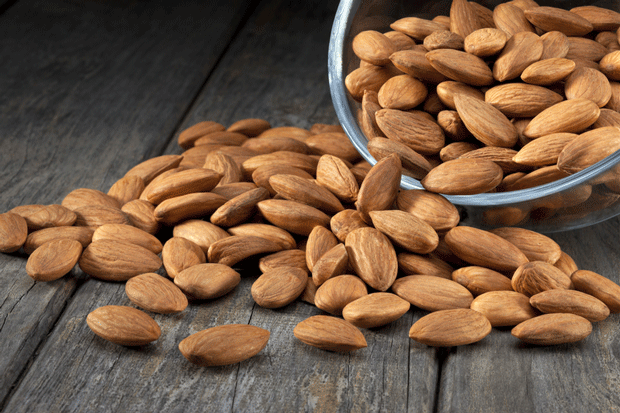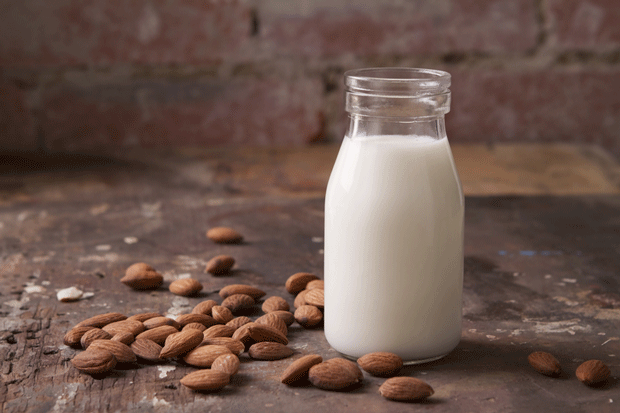How to make almond milk

Kristina Jensen talks about the health benefits of almonds, how to make milk from almonds, and what to do with the leftover pulp.
WORDS: Kristina Jensen
Sitting down to write this article, an image came to mind of my oldest son. He is now a handsome 6ft 4in giant, but my nostalgic snapshot is of him at 13 months, skidding around on his bottom on the kitchen floor of the old villa we lived in during the early 1990s. In his little paw he clutches his bottle, the contents a slightly off-white milky colour but it’s not cow’s milk – it’s almond milk.
It turned out he had allergies to dairy. I had decided not to go the long haul with breastfeeding like some of my friends, so weaning him was an exercise in research and experimentation. Almond milk came to our rescue and he loved it.
We tried making oat milk, millet milk, even peanut milk, but the almond version won hands down every time. We loved its creaminess and full body taste and discovered that we could add snippets of delectable extras to it and transform it into something rather stunning. Vanilla, organic mashed banana, dates, maple syrup or mānuka honey in our son’s bottle and a dash of Bailey’s or sambuca in the glasses of his sleep-deprived parents proved to be an excellent tonic at the day’s end.
Today, lactose intolerance is a household phrase in a country renowned for its dairy production. Many folks are looking for milk substitutes and to meet the demand manufacturers line the supermarket shelves with a dazzling and sometimes confusing array of milk alternatives. I have often stopped to read the ingredients list on a particular box only to find that it contains ingredients I’ve never heard of and can’t pronounce. The majority of milk substitutes are packaged in non-recyclable containers, one of my personal dislikes. My hope is that with these simple recipes you can start making your own almond milk.
ALL ABOUT ALMONDS
• Almonds are a great source of Vitamin E, manganese, magnesium, zinc, copper, riboflavin, selenium and phosphorus. Most of the fat in almonds is of the heart-healthy mono-saturated sort. They are not super high in calcium though – almonds contain one seventh the amount of calcium found in cow’s milk so cannot be regarded as a complete calcium replacement in your diet.
• However, soak your nuts and you bump up their nutritional profile considerably. When soaked, nuts begin to sprout which means increased enzyme activity, leading to greater absorption of the nutty nutrients. It also aids with digestibility.
• Almonds are an ancient food and the Romans referred to them as the ‘Greek nut’ as this was thought to be their place of origin.
• Historically, almond milk was also called amygdalate and was recommended as a substitute for animal milk during days of fasting.

HOW TO MAKE ALMOND MILK
Begin searching for recipes to make almond milk and the number of methods used can be a little daunting. Some call for soaking, blanching and/or peeling of the nuts and some don’t. I prefer to keep it very simple. However, I have come across another slightly more complicated variation on the almond milk theme called horchata. Across Latin America, this unique beverage is made with ground nuts as a key ingredient and although the drinks share the same name, the flavour of each is unique to its country of origin. I particularly like a Mexican one flavoured with cinnamon and vanilla. So you make the milk and then you have all this pulp left over. Back in the days when I made milk for my son, I fed it to the chickens! Today, I make crackers and biscuits that use up the excess fibre from the nuts in a deliciously responsible way.
BASIC ALMOND MILK RECIPE
This recipe makes a very creamy milk – add more water if you would like it to be less creamy – and you can add more dates/honey/maple syrup/agave syrup for a sweeter brew. Most of the commercial brands are very sweet so don’t be surprised if at first you find this recipe makes a milk which in comparison tastes bland.
● 1 cup natural almonds, soaked in cold water overnight
● 1 (or more) dates
● 1 tsp vanilla essence
● 2 cups of water
Discard the soaking water from the almonds. Use a blender or hand-held wand-type mixer to blend all the ingredients together until smooth. The almonds should be broken down into a very fine meal. Strain the milk through a fine cloth (muslin or cheese cloth is best), then gather the cloth around the almond meal and twist it closed. Squeeze and press with clean hands to extract the remaining almond milk.
Love this story? Subscribe now!
 This article first appeared in NZ Lifestyle Block Magazine.
This article first appeared in NZ Lifestyle Block Magazine.

